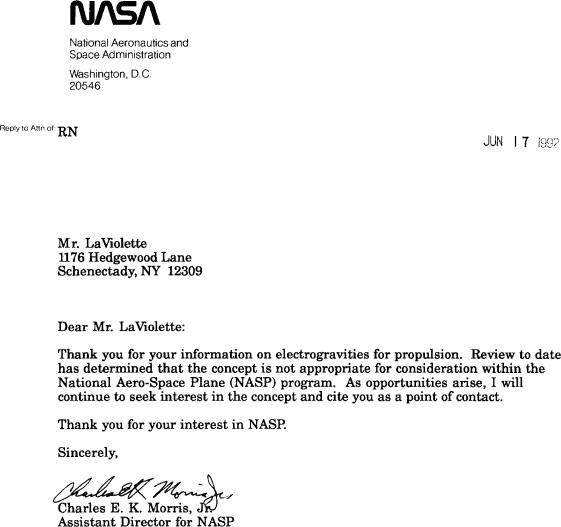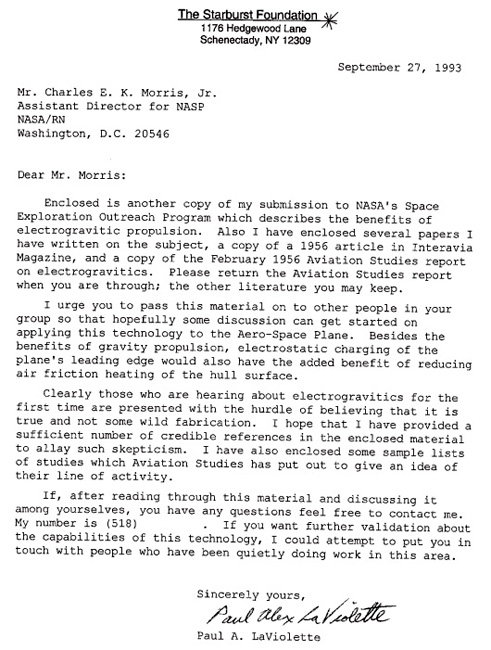Secrets of Antigravity Propulsion (60 page)

APPENDIX F
SECRET GOVERNMENT MEMOS CONCERNING OPERATION MAJESTIC TWELVE
Below is a reproduction of Dr.
Robert Sarbacher’s Canadian Department of Transportation memo describing the U.S.
effort to reverse-engineer UFO technology.
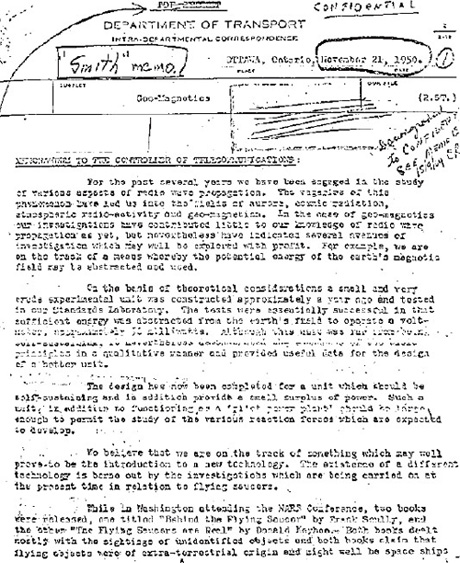
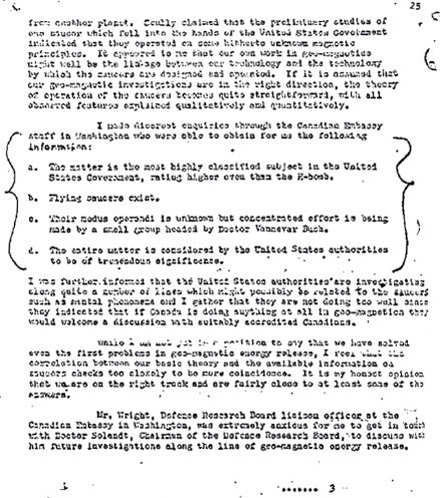
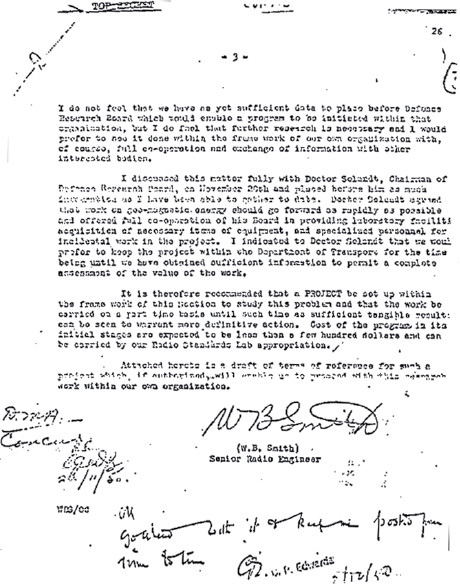
Below is a reproduction of the memorandum written by President
Harry Truman to establish the creation of the MJ-12 group.

APPENDIX G
ELECTROGRAVITICS: AN ENERGY-EFFICIENT MEANS OF SPACE PROPULSION
NASA SEOP Submission no.
100159
“Electrogravitics: An Energy-Efficient Means of Space Propulsion” is the abstract I submitted to NASA under the auspice of The Starburst Foundation—a nonprofit research institute I founded in 1984 to advance our understanding of the natural world.
E
LECTROGRAVITICS
: A
N
E
NERGY
-E
FFICIENT
M
EANS OF
S
PACE
P
ROPULSION
by Paul LaViolette, Ph.D.
The Starburst Foundation
Description.
The proposed propulsion technology would replace the energy-intensive rocket technology presently used for propelling spacecraft.
The technology, called electrogravitics, has already been developed in “black” defense research programs, programs so highly classified that their existence is not publicly acknowledged.
Electrogravitics may appear to violate certain assumptions about gravity commonly held by physicists and aeronautical engineers, so the reader is requested to keep an open mind.
The technology does exist; it has been under development for the past 40 years; and it has been shown to be feasible both in carefully controlled laboratory experiments and in actual test flights.
Basically electrogravitics is a technology that allows a spacecraft to artificially alter its own gravity field in such a manner that it is able to levitate itself.
This is accomplished by applying a megavolt pulsed DC electric potential across the outer hull and wing of the spacecraft.
The craft would be designed to have a relatively large body surface area, similar to the flying wing concept employed in the B-2 bomber.
Alternatively it could be discoidal in shape with a lenticular cross-section.
Thrust would always be in the direction of the craft’s positively charged surface.
To quote a February 1956 Air Force intelligence report (now declassified), such a craft “can perform the function of a classic lifting surface—it produces a pushing effect on the under surface and a suction effect on the upper, but unlike the airfoil, it does not require a flow of air to produce the effect.”
*43
Payoff.
The value of this technology is that the craft may achieve Earth orbit flight at a much lower velocity than conventional rocket propulsion and without the huge fuel expenditure.
It would eliminate the hazard of polluting the Earth’s stratosphere and space environment with aluminum oxide spherules, which has become an increasing problem with the solid fuel boosters currently in use.
The fuel requirements for electrogravitic propulsion are less than one percent of those presently used to lift the space shuttle into orbit.
Problems typically encountered with the Space Shuttle’s rocket propulsion technology (e.g., liquid hydrogen leaks, exhaust leaks around O-rings in the solid fuel booster) would not be present in this technology.
Due to its much lower power demands, electrogravitics is much safer and more economical.
Performance Characteristics
.
As early as 1956, an Air Force study estimated that a manned electrogravitic craft could achieve Mach 3 flight capability with a 50,000 kilowatt power requirement.
Such airborne electric power generation is within the reach of present technology.
It would require two General Electric superconducting generators powered by two 50,000 horsepower rocket turbine engines.
The superconducting generators mentioned here were developed for the Air Force in the late 1970’s for use in high-altitude aircraft.
Incidentally higher efficiencies are acheived in space due to reduced ion leakage from the hull’s charged surface.
Other enabling technologies.
All enabling technologies have been developed.
As early as 1958, a small scale model of an electrogravitic powered aircraft was able to lift 110% of its weight.
Since then manned vehicles have been secretly developed and are presently being test flown.
Relation to major mission objectives.
Electrogravitics would allow NASA to make frequent flights into space without the numerous delays presently plaguing the Space Shuttle launchings.
(The present three year wait for repairing the Hubble Telescope could be cut to 3 weeks.) It would allow flights directly from Earth to Mars without the necessity of laboriously constructing a Mars spaceship in Earth orbit.
Such a flight would no longer be contingent on the preexistence of a space station.
Moreover the high speeds potentially achievable with electrogravitics would allow travel to Mars to be made in under a month.
APPENDIX H
BEYOND ROCKET PROPULSION
NASA SEOP Submission no.
100153
The following is an abstract submitted to NASA by Joe Hughes.
BEYOND ELECTRIC PROPULSION
In the quest to save money in future space missions advanced propulsion designs are under consideration.
Electric propulsion is one of the designs proposed.
According to John Barnett, Supervisor of Electric Propulsion at Jet Propulsion laboratories, a system suitable for crewed spacecraft could be ready within fifteen years.
George McDonough, Director of Science and Engineering at the Marshall center, feels that electric propulsion “is an interesting alternative to nuclear propulsion which is the only one being considered by the agency,...They [the Soviets] consider it a viable way to do the job.
We ought to take a hard look at it before we make any final decisions” The object of the proposal is to reveal that an electric propulsion engine has already been tested and proven.
This engine was designed by Thomas Townsend Brown, a former physicist for the U.S.
Navy, and received U.S.
Patent number 3,022,430 on February 20, 1962, however the patent has expired so the design is no longer proprietary and can be considered by the Space Exploration Outreach Program.
This electric propulsion engine offers many substantial improvements over chemical and nuclear rockets.
Since it can convert the energy of electrical potential directly into mechanical force suitable for causing relative motion, without the aid of moving parts, tremendous gains in efficiency and reliability can be achieved.
Another advantage is that the engine can run effectively on Carbon Dioxide.
Since the atmosphere of Mars is largely CO
2
a probe or ship which used this design would not need to carry fuel to Mars to explore its surface or for the return journey to Earth.
Finally, no nuclear waste products or radiation is produced.
In contrast to conventional electric propulsion approaches which produce thrust by the accelerating gas only, the Brown engine ionizes the exiting gas, thus creating an electrical potential between the gas and the engine itself such that they repel each other.
With the result that, according to the patent, that the gas “thrust will be small compared to the electrokinetic thrust developed.”
In fact, a new principle is at work here.
Basically, Brown discovered that a sufficiently charged capacitor exhibits unidirectional thrust in the direction of the positive plate.
To prove that his capacitors involve something more than ion propulsion he immersed them in oil, a medium which does not
readily ionize and observed that the thrust was the same as in the air.
In early atmospheric tests, he used a power input of 50 watts to generate an electrical potential of 50,000 volts which caused his disc-shaped airfoils to fly at 12 miles per hour.
To further prove his point that something more than ion propulsion was at work here, he tested his discs in a
vacuum in the 1950’s under the auspices of a French corporation, La Societe Nationale de Construction Aeronautique Sud Quest (SNCASO).
He had theorized that the speed of his discs would increase exponentially with the voltage applied, and succeeded in flying some of his 3-foot discs in a vacuum at speeds of several
hundred miles an hour using an electrical potential of 200,000 volts.
Unfortunately, as a result of a corporate merger with another French company, Sud Est, propulsion efforts were dropped for unknown reasons to concentrate on airframe manufacture and design.
In the early sixties Townsend Brown organized his own corporation under the name Rand International Limited.
In spite of numerous patents, one of which is attached, and many demonstrations, success eluded him, the time was not right, people were too set on the Apollo way of doing things.
Now everything is fair game again, no Mars mission designs are set in stone, which is why I have resubmitted his idea.
APPENDIX I
CORRESPONDENCE WITH CHARLES MORRIS
Assistant Director for the National Aero-Space Plane Project
Below is a reproduction of my correspondence with Charles Morris, assistant director for the National Aero-Space Plane program.
